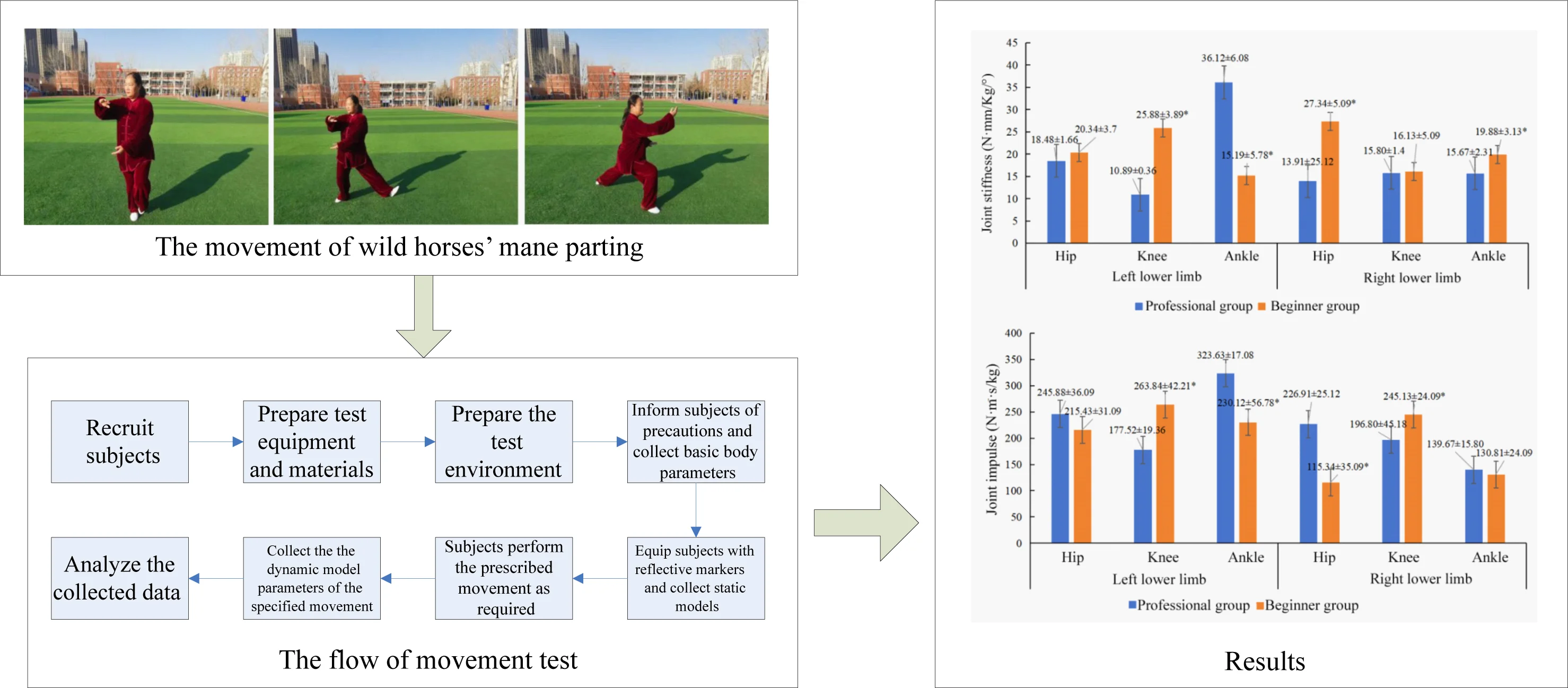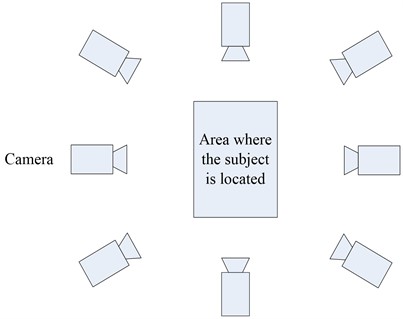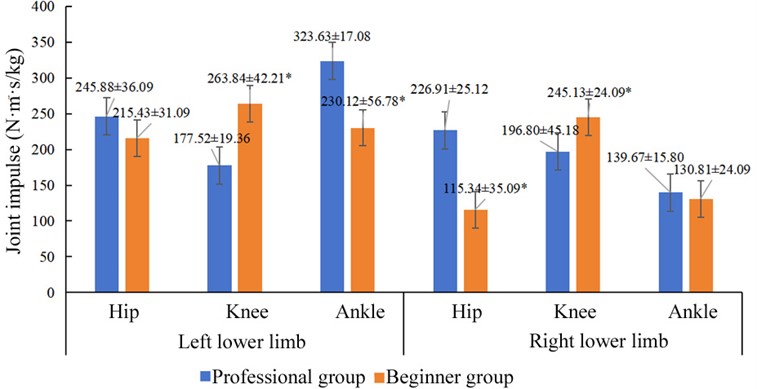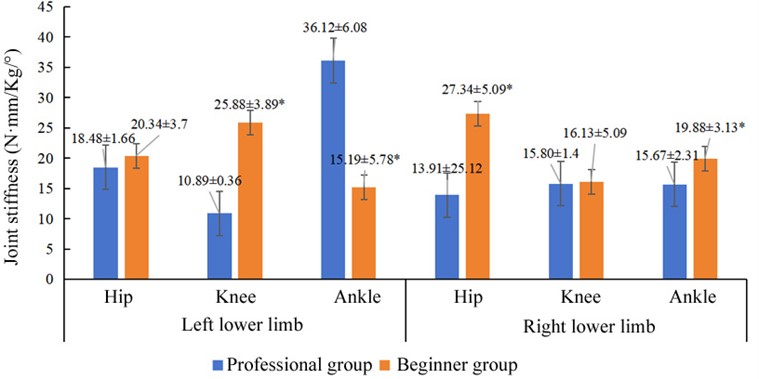Abstract
In the era of fitness, more and more young people are familiar with Taijiquan, a kind of physical fitness exercise. By conducting biomechanical analyses of the movements of Taijiquan, it is possible to exercise the body better. Numerous techniques in Taijiquan make it difficult to study each individually. Therefore, this paper studied the movement of “wild horses’ mane parting” in terms of biomechanics by analyzing the joint angle, stiffness, and impulse during this movement. Twenty male athletes were selected as subjects and divided into a professional group and a beginner group according to their training periods. High-speed cameras were used to shoot the “wild horses’ mane parting” movement. The angles of lower limb joints in these athletes were measured to calculate joint impulse and stiffness. The results showed that, compared with the professional group, there were significant differences in the adduction and abduction angle and the internal and external rotation angle between the beginner group and the professional group in the single-leg support movement stage ( 0.05). There were also significant differences in joint impulse and stiffness ( 0.05). Compared with beginners, long-term professional practitioners can make their movements more standardized. By comparing movements and data analysis, beginners can make their movements more standardized when practicing Taijiquan and avoid the risk of sports injury. The novelty of this article lies in the use of high-speed cameras to capture athletes’ movements, enabling accurate analyses of their joints and providing effective references for precise training.

Highlights
- The movement of wild horses’ mane parting was taken as the subject for biomechanical analysis.
- High-speed cameras were used to capture the joint angle, impulse, and stiffness of lower limbs.
- Professionals and beginners were compared to provide an effective reference for training beginners.
1. Introduction
Taijiquan originated from Chen style Taijiquan in the Ming Dynasty of China [1] and is closely related to Chinese traditional culture, medicine, and classical philosophy. Later, on the basis of these theories, a kind of slow and light boxing style combining strength and softness was gradually formed. However, while Taijiquan provides health benefits to people’s bodies, it also produces some problems. According to relevant data [2], some beginners do not have a comprehensive understanding of the theoretical knowledge of Taijiquan and are not able to master its skills, which leads to knee pain after practicing Taijiquan [3]. A literature search found that there is little literature about Taijiquan in foreign countries, most of which focus on the influence of Taijiquan on all aspects of the human body. For example, Song et al. [4] used the motion capture system and Vicon Nexus software for analysis and found that long-term non-standard Taijiquan posture of beginners would not only cause knee pain or injury but also affect the fitness effect. Meng [5] analyzed the images of athletes who have been practicing Taijiquan all year round and found that their hip joints were relatively relaxed, which verified the boxing principle of relaxing hips. Xu [6] conducted image analysis on the classic Taijiquan movement of “brush knee and twist step” and found that the movement of Taijiquan can improve the balance ability of the human body due to the frequent shift of the center of gravity. Hua [7] compared the movement characteristics of athletes who practiced Taijiquan to different degrees and discussed the influence of training years on the power generation of Taijiquan. It was found that people who practiced Taijiquan for a long time had better joint flexibility, punching posture, and application effect [8] than those who practiced Taijiquan for a short time. As can be seen from the development of the above studies, most of the conclusions of the literature are obtained through image and image analysis, and the influence of the movement on human function is discussed [9], but the experimental method is seldom used [10]. Based on sports biomechanics, this paper took literature, experiments, and mathematical statistics as the main research methods to compare and analyze the characteristics of lower limb joint chain between the professional group and the beginner group when practicing the movement of wild horses’ mane parting, so as to help improve the beginners’ cognition level of the technical norms of Taijiquan and avoid the risk of sports injury. The above-mentioned studies have analyzed various movements of Taijiquan, while this study utilized high-speed cameras to capture the Taijiquan movements performed by athletes and then deduced joint stiffness and impulse through changes in joint angles.
2. Case study
2.1. Subjects
The study subjects were 20 male athletes with no cerebrovascular, respiratory, or other diseases within two years. They all understood the purpose and procedure of the experiment and signed informed consent. In the experiment, the athletes were divided into a professional group and a beginner group according to their different years and degree of practice. Table 1 displays the basic information of the two groups, and no remarkable difference was observed. Moreover, the indicators of each group conformed to the results of the statistical analysis.
Table 1Basic information of experimental subjects
Group | Number of people () | Age (year) | Height (cm) | Weight (kg) | Time of practice (year) |
Professional group | 10 | 25.43±1.54 | 176±4.14 | 72.00±8.25 | 5.12±2.22 |
Beginner group | 10 | 25.17±1.91 | 177.2±3.16 | 69.35±7.25 | 3.12±1.56 |
2.2. Experimental equipment
The Miqus 3D motion capture system (Qualisys Company, Sweden) with eight high-speed cameras was employed. The basic parameters of the camera provided by the system were 1 MP pixel, a resolution of 1,216×800, and 250 fps. The kinematic data of members in the two groups when they practiced “wild horses’ mane parting” was collected. The sampling frequency was set at 100 Hz. The layout of the high-speed cameras is illustrated in Fig. 1.
Fig. 1The layout diagram of the high-speed cameras

2.3. Experimental process
The process of conducting the movement test is shown in Fig. 2. 1) Participants were recruited two months prior to the start of the experiment, and a total of 20 athletes were eventually recruited. 2) Equipment and materials required for the test were prepared. 3) One hour before the start of the test, the testing environment was arranged. 4) Prior to formal testing, the subjects were informed about precautions during the testing process, and their basic physical parameters were collected. 5) Reflective markers were pasted on their body surface according to the testing requirements, and the locations of these markers are shown in Table 2; their static models were captured using these reflective markers. 6) The formal testing began, and the subjects performed the required “wild horses’ mane parting” movement in Taijiquan and repeated it five times. 7) During the process of performing the test movement, reflective markers were used to capture the dynamic model parameters of the subjects. 8) The collected model parameters were analyzed.
Fig. 2The flow of movement test

Table 2Mark point names and locations
Left anterior superior iliac spine | LASI | Right anterior superior iliac spine | RASI |
Left posterior superior iliac spine | LPSI | Right posterior superior iliac spine | RPSI |
Left knee joint | LKNEE | Right knee | RKNEE |
Left thigh | LTHI | Right thigh | RTHI |
Left calf | LTIB | Right leg | RTIB |
Left ankle | LANK | Right ankle | RANK |
Left toe | LTOE | Right toe | RTOE |
Left heel | LHEE | Right heel | RHEE |
The movement “wild horses’ mane parting” can be separated into two stages. The first stage was the single-leg support stage: the time from the left leg support to the right heel touching the ground; the second stage was the double-leg support stage: from the moment when the right heel touches the ground to the end of the movement. Finally, the relevant data of members doing the movement of wild horses’ mane parting were collected. The movement in each stage is shown in Fig. 3.
Fig. 3Schematic diagram of wild horses’ mane parting

2.4. Data processing and indicator analysis
The Miqus motion capture software was used to collect the motion data of the subjects. The software’s built-in L-frame and T-type calibration frame were used for the static and dynamic calibration of the motion capture system, and the global coordinate system was established in the test space according to the principle of the Cartesian right-hand coordinate system. The acquired data were modeled, intercepted, and then imported into Visual 3D software to establish a human link model. Finally, the Butterworth filter was used to smooth the relevant data, and the low-pass filter was set to 10 Hz. The following tests were carried out.
(1) The angles of the hip, knee, and ankle joints were calculated when the subject was supported by one leg during the movement.
(2) Joint impulse and stiffness were also calculated, respectively. Joint impulse represents the integral of the human joint’s touchdown time under the action of the force. Its formula is:
where is the joint torque and t is the touchdown time.
(3) When calculating the stiffness of the hip, knee, and ankle joints during the exercise of wild horses’ mane parting, the formula for calculating the joint stiffness is:
where represents the variation of joint torque during the movement and represents the variation of joint angle during the movement.
2.5. Mathematical statistics
The experimental data were processed in SPSS 21.0 software. The data were recorded in the form of mean ± standard deviation (). The differences between groups were measured by independent sample t-test, and the significance level was 0.05. If 0.05, the difference was significant. Charts were drawn in Excel to show the experimental results.
3. Results
3.1. Joint angle of single-leg support in the movement of wild horses’ mane parting
As shown in Table 3, the adduction and abduction angle of the hip joint in the beginner group was 5.53±42.13, significantly different from that in the professional group ( 0.05). The internal and external rotation angle was 5.16±10.41, significantly different from that in the professional group ( 0.05). There were no significant differences in other joint angles between the two groups. It can be seen that subjects in the professional group achieved free contraction of all joints and torso in long-term practice, but beginners always relied on the same power chain to complete movements, and the main exercise joint was the knee joint, followed by the hip joint and ankle joint, which increased the possibility of damage to these joints.
3.2. Lower extremity joint impulse
According to the data in Fig. 4, when the members of the two groups completed the movement, the lower limb joint impulse was ordered from large to small. The beginner group showed a chain feature of “knee > ankle > hip”, while the professional group had the smallest impulse in the left and right limb hip joints. The average joint impulse of the left and right knees in the beginner group were 263.84±42.21 and 245.13±24.09, respectively, which were significantly higher than those of the professional group ( 0.05). The average joint impulses of the right hip and left ankle were 115.34±35.09 and 230.12±56.78, respectively, which were significantly lower than those of the professional group ( 0.05). In conclusion, subjects in the professional group are good at concentrating the cumulative load on the ankle joint, which can withstand the pressure, while subjects in the beginner group mainly concentrate the cumulative load on the knee joint. A high knee joint impulse will increase the contact stress of the knee joint and increase the risk of knee joint injury.
Table 3Comparison of lower limb joint angle during single-leg support (unit: °)
Joint action | Direction of movement | Professional group | Beginner group |
Hip joint | Flexion and extension | –35.12±4.48 | –41.53±6.13 |
Adduction and abduction | 12.56±19.43 | 5.53±42.13* | |
Internal and external rotation | 18.13±16.12 | 5.16±10.41* | |
Knee joint | Flexion and extension | 57.59±8.48 | 49.50±17.44 |
Adduction and abduction | 6.45±17.49 | 3.4±9 | |
Ankle joint | Flexion and extension | –100.67±4.49 | –110.2±4.32 |
Adduction and abduction | 3.45±16.79 | 2.11±8.45 | |
Internal and external rotation | 17.5±23.1 | 11.4±3 | |
Note: * indicates 0.05 when comparing the beginner and professional groups | |||
Fig. 4Comparison results of joint impulse in the lower extremity. Note: * indicates p< 0.05 when comparing the beginner and professional groups

3.3. Lower extremity joint stiffness
According to the data in Fig. 5, when practicing the movement of wild horses’ mane parting, the average joint stiffness of the left knee joint and ankle joint of the junior group was 25.88±3.89 and 15.19±5.78, respectively, which were significantly higher than those of the professional group ( 0.05). The average joint stiffness of the right hip joint and ankle joint in the beginner group were 27.34±5.09 and 19.88±3.13, respectively, which were significantly lower than those in the professional group ( 0.05). According to the joint stiffness, combined with the analysis of daily practice movements, it was found that the hip and knee joints of beginners were greatly hindered in practicing Taijiquan, which is contrary to the theory of Taijiquan movement and thus aggravates the risk of joint injury.
Fig. 5Comparison results of joint stiffness in the lower extremity. Note: * indicates p< 0.05 when comparing the beginner and professional groups

4. Discussion
Through the experimental research in this paper, it was found that when the members of the two groups respectively practiced the “wild horses’ mane parting” movement, it was found that the hip motion range of the beginner group was smaller, which precisely verified the theory that the hip motion range of the beginner group was smaller than that of the professional group obtained in the previous study [11]. In Taijiquan, if the hip joint motion range of athletes is limited, functional compensation will occur in the knee joint, and the degree of compensation is closely related to the degree of hip limitation [12]. This phenomenon indicates that the obstruction of the main motion joints during exercise will cause a compensatory effect on the adjacent joints. Therefore, because the movement of beginners was not standard, the angle between the hip joint and the trunk was small, affecting the other joints and increasing the risk of injury. In addition, from the data on lower limb joint impulse in Table 3, it can be seen that the knee joint impulse of the beginners was significantly greater than that of the professional group, while the impulse of the hip and ankle joints was significantly smaller than that of the professional group. However, the higher knee impulse of beginners will increase the contact stress of the knee joint [13] and the load borne by the knee joint. Therefore, if Taijiquan beginners maintain the wrong impulse chain characteristics for a long time, they can not only fail to meet the boxing theory requirements of “force starts from the feet and runs through the joints” [14] but also increase the risk of knee joint injury. The experimental data in this paper also showed that the hip and knee stiffness of beginners was significantly greater than that of the professional group, and the ankle joint stiffness was significantly smaller than that of the professional group. The concrete performance was that the hip and knee joints of beginners were significantly hindered in practicing Taijiquan, while in the professional group, the ankle joint was significantly hindered. It shows that when beginners do the movement, they habitually distribute the pressure to the hip and knee joint, ignoring the bearing effect of the ankle joint. Therefore, the practice of Taijiquan under the high tension of the hip joint is not only contrary to the technical requirements of “relaxed hip, open hip” but also aggravates the lower extremity load rate and results in sports injuries.
The above results show that in order to avoid adverse phenomena such as lower limb joint pain or patella outward movement due to the wrong or non-standard technical movements in the early stage of practicing Taijiquan, it is recommended that the beginner group follow the Taijiquan heir to learn, which will effectively avoid the occurrence of joint pain but also bring health to the body, such as increasing muscle strength and maintaining the balance of the body center of gravity.
The limitations of this study are the insufficient number of participants and the focus on a single Taijiquan movement. Therefore, future research directions include increasing the number of participants to enhance the generalizability of analysis results, as well as conducting biomechanical analyses on other movements in Taijiquan.
5. Conclusions
This paper analyzed the mechanical characteristics of wild horses’ mane parting in Taijiquan professionals and beginners from the perspective of biomechanics. After conducting a comparison of the joint angle, impulse, and stiffness between the two groups, significant differences were observed in the hip angle of the beginner group when compared to that of the professional group ( 0.05). The knee joint impulse of the beginner group was significantly higher than that of the professional group ( 0.05), and the impulse of the hip and ankle joints was significantly lower ( 0.05). The stiffness of the hip and knee joints of the beginner group was significantly higher than that of the professional group ( 0.05), and the stiffness of the ankle joint was significantly lower ( 0.05). The members in the beginner group had irregular movements, which led to the obstruction of lower limb joint movement during the Taijiquan exercise. Therefore, beginners can get familiar with Taijiquan better through more guidance from professionals.
The limitation of this article lies in the analysis of only one movement of Taijiquan using high-speed cameras, which is slightly insufficient for guiding Taijiquan training. Therefore, future research directions include further biomechanical analysis of other movements in Taijiquan.
References
-
W. Fu, “Biomechanical analysis of the independent movement of the 360° joint lifting of the knee and lotus in the air for excellent male Tai Chi athletes in Shaanxi Province,” (in Chinese), Xi’an Institute of Sports, 2019.
-
L. Wang, “Analysis of movement and technical factors in competitive Tai Chi competition results,” (in Chinese), Sports Science and Technology Literature Bulletin, Vol. 28, No. 11, pp. 62–66, 2020.
-
G. Zhang, “Analysis of c-level difficulty movement techniques in Tai Chi boxing: taking the 540 ° flying lotus and sparrow earth dragon movement as an example,” (in Chinese), Guizhou Sports Science and Technology, No. 1, pp. 46–49, 2019.
-
H. Liu, “On the training method of the 540 °catching sparrow and earth dragon movement with flying feet in the air and swinging lotus in the air,” (in Chinese), Contemporary Sports Technology, Vol. 10, No. 10, pp. 225–226, 2020.
-
X. Shao and H. Tao, “Research on scientific training of competitive Tai Chi from the perspective of project essence characteristics,” (in Chinese), Western Leather, Vol. 42, No. 4, p. 91, 2020.
-
P. Yi, L. Wang, and P. Yi, “Exploration of training methods for exercise techniques of Tai Chi athletes,” (in Chinese), Sports Science and Technology Literature Bulletin, Vol. 27, No. 1, pp. 54–56, 2019.
-
H.M. Lo, C.Y. Yeh, S.C. Chang, H.C. Sung, and G. D. Smith, “A Tai Chi exercise programme improved exercise behaviour and reduced blood pressure in outpatients with hypertension,” International Journal of Nursing Practice, Vol. 18, No. 6, pp. 545–551, Nov. 2012, https://doi.org/10.1111/ijn.12006
-
S.-K. Tse and D. M. Bailey, “T’ai Chi and postural control in the Well Elderly,” The American Journal of Occupational Therapy, Vol. 46, No. 4, pp. 295–300, Apr. 1992, https://doi.org/10.5014/ajot.46.4.295
-
M. Grimmer, R. Riener, C. J. Walsh, and A. Seyfarth, “Correction to: mobility related physical and functional losses due to aging and disease – a motivation for lower limb exoskeletons,” Journal of NeuroEngineering and Rehabilitation, Vol. 17, No. 1, pp. 1–21, Feb. 2020, https://doi.org/10.1186/s12984-020-0648-z
-
X. Chen, X. Li, and C. Chen, “The impact of healthy lifestyle and psychological factors on the risk of falls in elderly people,” (in Chinese), Chinese Journal of Gerontology, Vol. 38, No. 23, pp. 5821–5823, 2018.
-
L. Zhou, “Theory and practice of sports human body science. Part 1,” (in Chinese), Shaanxi Normal University Press Co., Ltd., 2016.
-
S. H. Wong, T. Ji, Y. Hong, S. L. Fok, and L. Wang, “Foot forces induced through tai chi push-hand exercises,” Journal of Applied Biomechanics, Vol. 29, No. 4, pp. 395–404, Aug. 2013, https://doi.org/10.1123/jab.29.4.395
-
H. Li, K. Huang, N. Liu, and J. Yang, “Characteristics and development trends of the application of Tai Chi pushing techniques under the new rules,” (in Chinese), Journal of Beijing Sport University, Vol. 41, No. 1, pp. 140–144, 2018.
-
Z. Wang, “Analysis of biomechanical characteristics of Tai Chi pushing hand release technique,” (in Chinese), Beijing Sport University, 2016.
About this article
The authors have not disclosed any funding.
The datasets generated during and/or analyzed during the current study are available from the corresponding author on reasonable request.
The authors declare that they have no conflict of interest.
